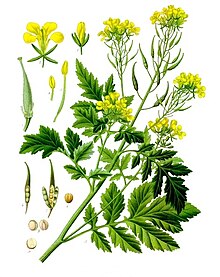bio.wikisort.org - Plant
White mustard (Sinapis alba) is an annual plant of the family Brassicaceae. It is sometimes also referred to as Brassica alba or B. hirta. Grown for its seeds, used to make the condiment mustard, as fodder crop, or as a green manure, it is now widespread worldwide, although it probably originated in the Mediterranean region.

Description
White mustard is an annual, growing to 70 centimetres (28 in) high with stalkless pinnate leaves, similar to Sinapis arvensis.[1]
Distribution
Most common in Europe, North Africa, the Middle East and Central Asia, it can be found worldwide. It has been found as far north as Greenland,[2] and naturalized throughout Great Britain and Ireland.[3]
Culinary uses
The yellow flowers of the plant produce glabrous or sparsely bristled seed pods. Each fruit (silique) contains roughly a half dozen seeds. The plants are harvested for their seeds just prior to the seed pods becoming ripe and bursting open (dehiscing).
White mustard seeds are hard spheroid seeds, usually around 1.0 to 1.5 mm (0.039 to 0.059 in) in diameter,[4] with a color ranging from beige or yellow to light brown. They can be used whole for pickling or toasted for use in dishes. When ground and mixed with other ingredients, a paste or more standard condiment can be produced. Sinapis alba is used to make the commonplace yellow table mustard, with additional yellow coloring provided by turmeric in some formulations.
The seeds contain sinalbin, which is a thioglycoside responsible for their pungent taste. White mustard has fewer volatile oils and the flavor is considered to be milder than that produced by black mustard seeds.[5][6]
In Greece, the plant's leaves are eaten during the winter, before it blooms. Greeks call it vrouves (βρούβα) or lapsana (λαψάνα). The blooming season of this plant (February–March) is celebrated with the Mustard Festival, a series of festivities in the wine country of California (Napa and Sonoma Counties).[citation needed]
Other uses
White mustard is commonly used as a cover and green manure crop in Europe (between UK and Ukraine). A large number of varieties exist,[7][8] mainly differing in lateness of flowering and resistance against white beet-cyst nematode (Heterodera schachtii). Farmers prefer late-flowering varieties, which do not produce seeds, as they may become weeds in the subsequent year. Early vigor is important to cover the soil quickly to suppress weeds and protect the soil against erosion. In rotations with sugar beets, suppression of the white beet-cyst nematode is an important trait. Resistant white mustard varieties reduce nematode populations by 70-90%.[citation needed]
Gallery
- flowering plant
- plant
- flowers
- seed pods
- cover crop
See also
- Mustard plant
- Mustard seed
References
- Webb, D.A., Parnell, J. and Doogue, D. 1996. An Irish Flora. Dundalgan Press Ltd., Dundalk. ISBN 0-85221-131-7
- Beesley, S. and Wilde, J. 1997. Urban Flora of Belfast. The Institute of Irish Studies and The Queen's University of Belfast. ISBN 0-85389-695-X.
- Clapham, A.R., Tutin, T.G. and Warburg, E.F. 1968 Excursion Flora of the British Isles. Cambridge University Press. ISBN 0-521-04656-4
- Balke, D. (2000). "Rapid aqueous extraction of mucilage from whole white mustard seed". Food Research International. 33 (5): 347–356. doi:10.1016/S0963-9969(00)00055-7.
- Tan, S. H. (2011). "Extraction and residual antinutritional components in protein fractions of Sinapis alba and Brassica napus oil-free meals". 17th Australian Research Assembly on Brassicas (ARAB). Wagga Wagga, NSW: 107.
- Garland, S. (1993). The Complete Book of Herbs & Spices: An Illustrated Guide to Growing and Using Culinary, Aromatic, Cosmetic and Medicinal Plants. Frances Lincoln Limited, Rydalmere, NSW, Australia. ISBN 978-0340584699.
- Germany
- Netherlands
External links
- Sinapis alba Flowers in Israel
- Sinapis alba in the CalPhotos photo database, University of California, Berkeley
- "Sinapis alba". Calflora. Berkeley, California: The Calflora Database.
- "Sinapis alba". Plants for a Future.
- http://www.maltawildplants.com/CRUC/Sinapis_alba.php Comprehensive profile for Sinapis alba.
На других языках
- [en] White mustard
[es] Sinapis alba
La mostaza blanca (Sinapis alba) es una planta anual de la familia de las Crucíferas. A veces se la conoce como Brassica alba, Brassica hirta o mostaza amarilla. Se la cultiva comercialmente por sus semillas de mostaza en prácticamente todo el mundo, siendo sin embargo originaria probablemente de la región mediterránea. Las flores amarillas de la planta producen un tipo de vainas (silicuas) vellosas que contienen las semillas, en las que encontraremos aproximadamente media docena de semillas por vaina. La cosecha de la semilla de la mostaza se hace justo antes de que dichas vainas maduren del todo y se abran. Las semillas de esta especie de mostaza son redondas y de consistencia dura, de en torno al milímetro o 2 mm. de diámetro, y con un color que puede ir del beige o el amarillo al marrón claro.[fr] Moutarde blanche
Sinapis alba[it] Sinapis alba
La senape bianca (Sinapis alba L., 1753) è una pianta annuale della famiglia Brassicaceae.[1] Coltivata per i suoi semi, come foraggio e come sovescio per migliorare la fertilità dei terreni, è oggi diffusa in tutto il mondo, sebbene sia originaria probabilmente del bacino del Mediterraneo.[ru] Горчица белая
Горчи́ца бе́лая[2][3], или Английская белая горчица[4] (лат. Sinápis álba) — вид однолетних травянистых растений рода Горчица (Sinapis) семейства Капустные (Brassicaceae). Лекарственное, кормовое и медоносное растение[5][3].Другой контент может иметь иную лицензию. Перед использованием материалов сайта WikiSort.org внимательно изучите правила лицензирования конкретных элементов наполнения сайта.
WikiSort.org - проект по пересортировке и дополнению контента Википедии





